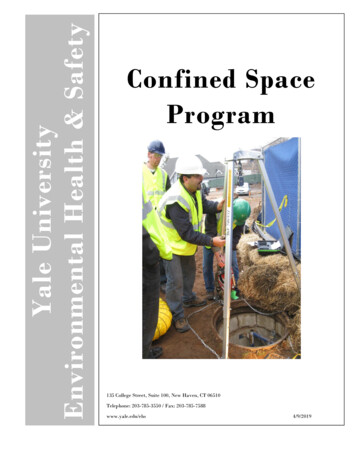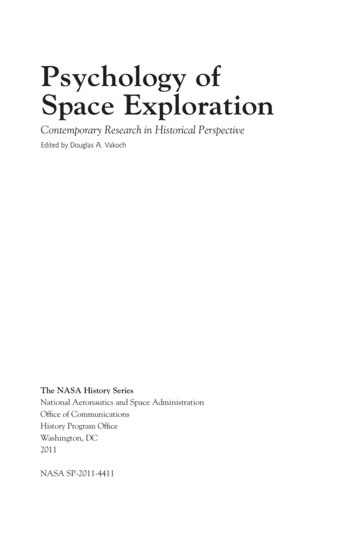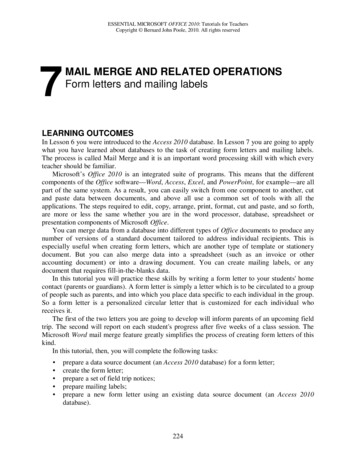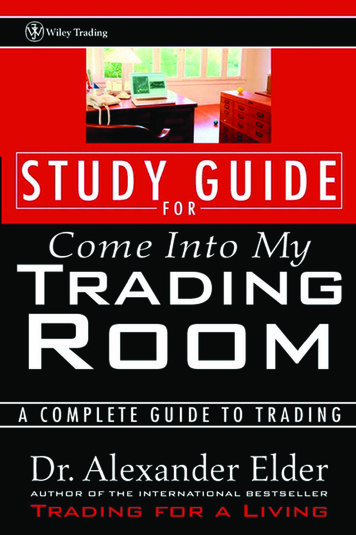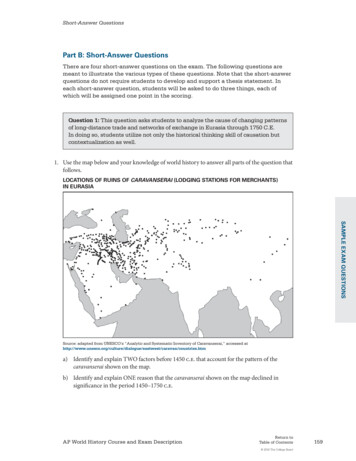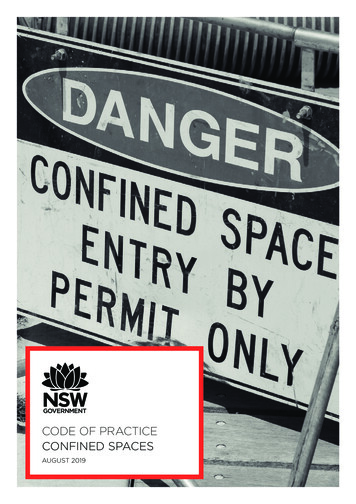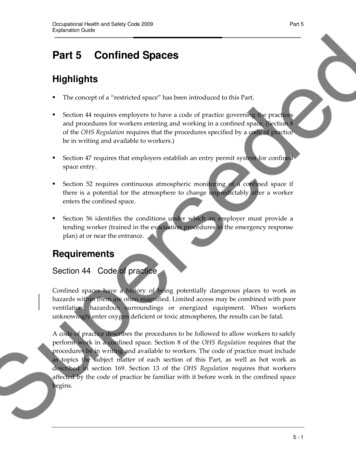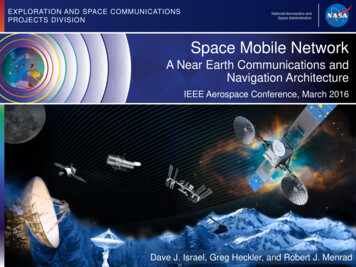
Transcription
Name:Class:Date:Space Questions 135 QuestionsTime:Marks:Comments:
Q1.The figure below shows what scientists over 1000 years ago thought the solar system waslike.(a)Give one way that the historical model of the solar system shown in the figureabove is different from what we now know about the solar system.(1)(b)Give one way that the solar system shown in the figure above is the same as whatwe now know about the solar system.(1)(c)The first artificial satellite to orbit the Earth was launched into space in 1957.Describe the orbit of an artificial satellite.(1)(d)What provides the force needed to keep a satellite in its orbit?Tick one box.friction
gravitytension(1)(e)All stars go through a lifecycle.The star Mira will go through a supernova stage in its lifecycle but the Sun will not.How is the star Mira different to the Sun?(1)(Total 5 marks)Q2.In 1929, the astronomer Edwin Hubble observed that the light from galaxies moving awayfrom the Earth had longer wavelengths than expected.(a)What name is given to this effect?(1)(b)From his observations, Hubble was able to calculate the speed of a galaxy and thedistance of the galaxy from the Earth.Figure 1 shows the results of Hubble’s calculations.Figure 1
What relationship between the speed of a galaxy and the distance is suggested byHubble’s results?(1)The observations made by Hubble support the idea that the Universe is expanding. Thismeans that galaxies are continually moving away from each other and from the Earth.Figure 2 shows a student using a balloon to model the idea of an expanding Universe.Some dots, which represent galaxies, were marked on the balloon.The balloon was then inflated.Figure 2(c)Give one strength and one weakness of this model in representing the idea of anexpanding Universe.StrengthWeakness(2)In the 1950s there were two main theories to explain how the Universe began.(d)In what way do the observations made by Hubble support both Theory 1 and Theory2?
(1)(e)Most scientists now believe that Theory 2 is correct.Suggest what is likely to have caused scientists to start thinking Theory 1 is wrong.(1)(Total 6 marks)Q3.(a)The figure below shows how a star is formed.Use one answer from each box to complete the sentences.(3)(b)Elements heavier than iron are formed in a supernova.What is a supernova?Tick ( ) one box.the explosion of a massive stara very bright, hot young star
a very cool super giant star(1)(c)Brown dwarf stars are small stars too cool to give out visible light. They were firstdiscovered in 1995. Scientists think that there are millions of these stars spreadthroughout the Universe.Which one of the following is the most likely reason why brown dwarf stars were notdiscovered before 1995?Tick ( ) one box.Brown dwarf stars did not exist before 1995.Scientists were looking in the wrong part of the Universe.The telescopes and measuring instruments were notsensitive enough.(1)(Total 5 marks)Q4.(a)Brown dwarf stars are thought to have been formed in the same way as other stars.They are too small for nuclear fusion reactions to take place in them.Brown dwarf stars emit infrared radiation but are not hot enough to emit visible light.(i)Describe how a star is formed.(2)(ii)Describe the process of nuclear fusion.(1)(iii)Scientists predicted that brown dwarf stars existed before the first one wasdiscovered in 1995.Suggest one reason why scientists are now able to observe and identifybrown dwarf stars.
(1)(b)In the 18th century some scientists suggested a theory about how the planetsformed in the Solar System. The theory was that after the Sun formed, there werecool discs of matter rotating around the Sun. These cool discs of matter formed theplanets. The scientists thought this must have happened around other stars too.(i)Thinking about this theory, what would the scientists have predicted to havebeen formed in other parts of the Universe?(1)(ii)Since the 1980s scientists studying young stars have shown the stars to besurrounded by cool discs of rotating matter.What was the importance of these observations to the theory the scientistssuggested in the 18th century?(1)(c)The Earth contains elements heavier than iron.Why is the presence of elements heavier than iron in the Earth evidence that theSolar System was formed from material produced after a massive star exploded?(1)(Total 7 marks)Q5.The early Universe contained only the lightest element.(a)Use the correct answer from the box to complete the sentence.hydrogenironuraniumThe early Universe contained only .(1)(b)Use the correct answer from the box to complete the sentence.main sequence starprotostarsupernovaThe heaviest elements are formed only in a .(1)
(c)Use the correct answer from the box to complete the sentence.red giantred super giantwhite dwarfOnly a star much bigger than the Sun can become a .(1)(d)The Universe now contains a large variety of different elements.Describe how this happened.(4)(Total 7 marks)Q6.Scientists can use the visible light spectrum from distant stars to determine whether thestars are moving.The visible light spectrum from stars includes dark lines at specific wavelengths.(a)The diagram shows the visible light spectrum from the Sun and from four otherstars, A, B, C and D.
(i)Which star, A, B, C or D, is moving away from the Earth?(1)(ii)How does the speed of star B compare with the speed of star D?Tick ( ) one box.Tick ( )The speed of star B is greater than the speed of star D.The speed of star B is less than the speed of star D.The speed of star B is the same as the speed of star D.(1)(b)A radio wave is emitted by a star.The radio wave has a wavelength of 1500 m and a frequency of 200 000 Hz.Calculate the speed of this radio wave.Choose the correct unit from the list below.mm/sm / s2
Speed unit(3)(Total 5 marks)Q7.A teacher demonstrates the production of circular waves in a ripple tank.Diagram 1 shows the waves at an instant in time.Diagram 1(a)Show on Diagram 1 the wavelength of the waves.(1)(b)The teacher moves the source of the waves across the ripple tank.Diagram 2 shows the waves at an instant in time.Diagram 2(Actual size)(i)Use the correct answer from the box to complete each sentence.
decreasedincreasedstayed the sameIn Diagram 2, the observed wavelength of the waves at Xhas .In Diagram 2, the frequency of the waves at Xhas .(2)(ii)Take measurements from Diagram 2 to determine the wavelength of thewaves received at X.Give the unit.Wavelength (3)(c)The teacher uses the waves in the ripple tank to model the changes in thewavelengths of light observed from distant galaxies.When observed from the Earth, there is an increase in the wavelength of light fromdistant galaxies.(i)State the name of this effect.(1)(ii)What does this increase in wavelength tell us about the movement of mostgalaxies?(1)(iii)Explain how this observation supports the Big Bang theory of the formation ofthe Universe.
(4)(iv)State one other piece of evidence that supports the Big Bang theory of theformation of the Universe.(1)(Total 13 marks)Q8.Astronomers claim that there are about 300 billion stars in the Milky Way.(a)Describe how stars are formed.(3)(b)Use the correct answer from the box to complete the sentence.decayfissionfusionEnergy is released in stars by the process of nuclear .(1)(c)State why a star is stable during the ‘main sequence’ period of its life cycle.(1)(d)The life cycle of a star after the ‘main sequence’ period depends on the size of thestar.A particular star is the same size as the Sun.
What are the stages, after the main sequence, in the life cycle of this star?State them in order by writing in the boxes.(3)(Total 8 marks)Q9.(a)Figure 1 shows the life cycle of a very large star.Use the correct answers from the box to complete the sentences in Figure 1.main sequence starneutron starsupernovawhite dwarfFigure 1Gas and dust join together to become a protostar.The star is stable as a .The star expands to become a red super giant.
The outer layers of the star explode as a .The core of the star shrinks and a black hole is formed.(2)(b)Figure 2 shows the forces acting on a star when the star is stable.Figure 2Draw a ring around the correct answer to complete the sentence.bigger thanWhen a star is stable, the forces pushing outwards aresmaller thanbalanced bythe forces pulling inwards.(1)(Total 3 marks)Q10.Man-made satellites can orbit the Earth, as shown in the figure below.
The satellite experiences a resultant force directed towards the centre of the orbit.The resultant force is called the centripetal force(a)What provides the centripetal force on the satellite?(1)(b)State two factors that determine the size of the centripetal force on the satellite.1.2.(2)(c)The table below gives data for five different satellites orbiting the Earth.SatelliteAverage heightabove Earth’ssurface inkilometresTime taken toorbit Earth onceinminutesMass of satellitein kilogramsA37093419 000B69799280C827103630D5 900228400E35 80014402 030(i)State the relationship, if any, between the height of the satellite above theEarth’s surface and the time taken for the satellite to orbit the Earth once.(1)(ii)State the relationship, if any, between the time taken for the satellite to orbitthe Earth once and the satellite’s mass.(1)(d)Over 300 years ago, the famous scientist Isaac Newton proposed, with a ‘thoughtexperiment’, the idea of satellites.Newton suggested that if an object was fired at the right speed from the top of a highmountain, it would circle the Earth.Why did many people accept Isaac Newton’s idea as being possible?Tick ( ) one box.
Isaac Newton was a respected scientist who had made new discoveries before.Isaac Newton went to university.It was a new idea that nobody else had thought of before.(1)(Total 6 marks)Q11.(a)Observation of the spectra from distant galaxies provides evidence to support the‘Big Bang’ theory.(i)Complete the following sentence.Many scientists think that the ‘Big Bang’ theory describes the(1)(ii)Tick ( ) one box to complete the sentence.The discovery of cosmic microwave background radiation was importantbecause it .proved the ‘Big Bang’ theory to be correct.provided more evidence to support the ‘Big Bang’theory.proved the Universe will continue to expand forever.(1)(b)Many stars are part of a binary star system. Binary star systems have two stars.The visible spectrum from stars includes dark lines. These lines are at specific
wavelengths.The diagram shows the position of two dark lines in the spectrum from the Sun. Italso shows the same lines in the spectra from two stars A and B in a binary starsystem at the same point in time.(i)What name is given to the effect shown in the spectrum from star A?(1)(ii)Scientists have concluded that the two stars in a binary star system orbitaround a fixed point between the two stars.A comparison of the spectra from the two stars in a binary star systemprovides evidence to support this conclusion.Explain how.(3)(Total 6 marks)Q12.(a)Scientists have observed that the wavelengths of the light from galaxies movingaway from the Earth are longer than expected.(i)What name is given to this observation?
(1)(ii)Draw a ring around the correct answer to complete each sentence.light can be stretched.This observation gives scientists evidence thatgalaxies are changing colour.the Universe is expanding.(1)(iii)There is a pattern linking the size of the observed increase in the wavelengthsof light from a galaxy and the distance the galaxy is from the Earth.Which one of the graphs, L, M or N, shows the correct pattern?Write the correct answer in the box.(1)(b)Observations help scientists answer questions about the Universe.Scientists cannot answer every question.Which one of the following questions cannot be answered by scientists?Tick ( ) one box.How old is the Universe?Why was the Universe created?How fast does light travel through theUniverse?(1)(Total 4 marks)Q13.Galaxies emit all types of electromagnetic wave.
(a)(i)Which type of electromagnetic wave has the shortest wavelength?(1)(ii)State one difference between an ultraviolet wave and a visible light wave.(1)(b)Electromagnetic waves travel through space at a speed of 3.0 x 108 m/s.The radio waves emitted from a distant galaxy have a wavelength of 25 metres.Calculate the frequency of the radio waves emitted from the galaxy and give theunit.Frequency (3)(c)Scientists use a radio telescope to measure the wavelength of the radio wavesemitted from the galaxy in part (b) as the waves reach the Earth. The scientistsmeasure the wavelength as 25.2 metres. The effect causing this observed increasein wavelength is called red-shift.(i)The waves emitted from most galaxies show red-shift.What does red-shift tell scientists about the direction most galaxies aremoving?(1)(ii)The size of the red-shift is not the same for all galaxies.What information can scientists find out about a galaxy when they measurethe size of the red-shift the galaxy produces?(2)(iii)What does the observation of red-shift suggest is happening to the Universe?
(1)(Total 9 marks)Q14.Stars go through a life cycle. About 90 % of all stars are in the ‘main sequence’ period ofthe life cycle.(a)Stars are stable during the ‘main sequence’ period of the life cycle.Why?(1)(b)The table gives an estimated time for the number of years that three stars, X, Y andZ, will be in the ‘main sequence’ period of their life cycle.(i)StarRelative mass of the starcompared to the SunEstimated ‘mainsequence’ period inmillions of yearsX0.14 000 000Y1.09 000Z40.0200This data suggests that there is a pattern linking the mass of a star and thenumber of years the star is in the ‘main sequence’ period of its life cycle.What is the pattern suggested by the data?(1)(ii)Scientists cannot give the exact number of years a star will be in the ‘mainsequence’ period.Suggest why.(1)(iii)Nuclear fusion is the process by which energy is released in stars.Which one of the following can be concluded from the data in the table?Draw a ring around the correct answer in the box to complete the sentence.
faster thanThe rate of nuclear fusion in a large star isthe same asin a small star.slower thanExplain the reason for your answer.(3)(c)In this question you will be assessed on using good English, organising informationclearly and using specialist terms where appropriate.Describe what happens to a star much bigger than the Sun, once the star reachesthe end of the ‘main sequence’ period of its life cycle.Your answer should include the names of the stages the star passes through.(6)(Total 12 marks)Q15.The diagram shows part of the lifecycle of a very large star.Use words or phrases from the box to complete the sentences contained in the diagram.black holered supergiantsupernovawhite dwarf(3)The star is stable.
The star expands forminga .The star collapses, the outer layers explodeas a .The centre collapses further and further untilit finally forms a .(Total 3 marks)Q16.The diagram, which is not to scale, shows two satellites, L and M, orbiting the Earth.(a)Complete the following table.Each letter, L or M, may be used once, more than once, or not at all.Statement about the satelliteLetter for thesatelliteIt is used as a monitoring satellite.It is a geostationary satellite.It takes 24 hours to complete its orbit.(2)(b)Complete the following sentence.To stay in its present orbit around the Earth, each satellite must move at
a particular .(1)(c)Thousands of satellites are now in orbit around the Earth. A student used theinternet to collect information about some of them.Name of satelliteAveragedistance fromthe centre of theEarth inkilometresSpeed inkilometres persecondTime taken toorbit the EarthThe Moon391 4001.0128 daysGEO42 2003.071 dayNavstar26 6003.8712 hoursLageos12 3005.703.8 hoursHST7 0007.5697 minsISS6 7007.6892 mins(i)The Moon takes a longer time than any of the other satellites to orbit the Earth.Give one other way in which the Moon is different from the other satellites inthe table.(1)(ii)What conclusion on the relationship between the average distance and speedcan the student come to on the basis of this data?(1)(Total 5 marks)Q17.Read this statement from a website.Immediately after the ‘big bang’, at the start of the Universe,there were only atoms of the element hydrogen (H).Now there are over one hundred elements.Scientists think that all the elements on Earth are alsopresent throughout the Universe.(a)Explain how atoms of the element (He) are formed in a star.
(2)(b)Explain how atoms of very heavy elements, such as gold (Au), were formed.(2)(c)Scientists have only examined a tiny fraction of the Universe.What is the basis for scientists thinking that the elements found on Earth are presentthroughout the Universe?(1)(Total 5 marks)Q18.The ‘big bang’ theory is one theory explaining the origin of the Universe.(a)The graphs X, Y and Z, show how the size of the Universe may have changed withtime.Which graph would the ‘big bang’ theory suggest is correct?Write your answer, X, Y or Z, in the box.Explain the reason for your answer.
(3)(b)In 1948, an alternative to the ‘big bang’ theory, called the ‘steady state’ theory, wasdeveloped.The ‘steady state’ theory suggested that the Universe, although expanding, hasalways existed without a beginning in time.(i)Complete the following sentence by drawing a ring around the correct line inthe box.The measurement of red-shift in the light from distant galaxies providesevidenceonly the ‘big bang’ theory.to supportonly the ‘steady state’ theory.both the ‘big bang’ and ‘steady state’ theories.(1)(ii)In 1965, scientists rejected the ‘steady state’ theory in favour of the ‘big bang’theory.Suggest what might cause scientists to stop supporting one theory and to startsupporting an alternative theory.(1)(Total 5 marks)Q19.(a)Starting with the smallest, list the following in order of increasing size.UniverseEarthMilky WaySunSmallestLargest(2)(b)Stars pass through different stages during their life cycle.The diagram shows the forces acting on the Sun during the stable stage of its lifecycle.
Complete the following sentence by drawing a ring around the correct line in thebox.During the stable stage of the Sun’s life cycle, the forces pulling inwardssmaller thanareequal tothe forces pushing outwards.bigger than(1)(c)During its life cycle, the Sun will never go through a supernova stage but the starMira will.(i)What is a supernova?(1)(ii)Explain why the Sun will not go through the supernova stage but the star Mirawill.(2)(Total 6 marks)Q20.(a)The ‘Big Bang’ theory uses red-shift as evidence to explain the beginning of theUniverse.How does the red-shift from distant galaxies provide evidence for the beginning ofthe Universe?
(3)(b)Cosmic microwave background radiation (CMBR) is a type of electromagneticradiation. CMBR fills the Universe. It was first discovered in 1965 by twoastronomers called Penzias and Wilson.(i)What do scientists believe is the origin of CMBR?(1)(ii)Why was the discovery of CMBR so important to the scientists believing the‘Big Bang’ theory to be correct?(1)(iii)How is the wavelength of CMBR likely to change, if at all, over the next billionyears?Give a reason for your answer.(2)(Total 7 marks)Q21.(a)As part of its life cycle, a star changes from being a protostar to a main sequencestar.Explain the difference between a protostar and a main sequence star.(2)(b)The early Universe contained only atoms of hydrogen. The Universe now containsatoms of over one hundred different elements.Explain how the different elements now contained in the Universe were formed.
(3)(Total 5 marks)Q22.Optical telescopes may be used to observe galaxies. Some optical telescopes are on theEarth and some are on satellites in space.Scientists have observed that the wavelengths of the light from galaxies moving awayfrom the Earth are longer than expected. This observation is called red-shift.(i)What does the size of the red-shift tell the scientists about the distance a galaxy isfrom the Earth?(1)(ii)Complete the following passage.Red-shift provides evidence to support the ‘big bang’ theory. The ‘big bang’ theory isone of the ways of explaining the of the Universe.(1)(Total 2 marks)Q23.Objects moving in a circle experience a force called centripetal force, which acts to thecentre of the circle.The diagram shows the apparatus used by two students to find out how the centripetalforce acting on an object affects the speed of the object.
(a)(i)In which direction does the centripetal force act on the rubber bung?(1)(ii)In this investigation, what provides the centripetal force?(1)(b)One student swung the rubber bung around in a circle at constant speed. Thesecond student timed how long it took the rubber bung to complete 10 rotations. Thestudents then calculated the speed of the rubber bung, using the radius of the circleand the time to complete one rotation. The students repeated this for severaldifferent values of centripetal force.(i)During the investigation, the radius of the circle and the mass of the rubberbung were not changed.Explain why.(2)(ii)One of the variables in this investigation was the time taken by the rubberbung to complete 10 rotations.Which two words can be used to describe this variable?Draw a ring around each of your two ii)The students timed 10 rotations of the rubber bung, rather than just onerotation.Suggest why.(1)(c)The graph shows the students’ data.
There is a relationship between the speed of an object moving in a circle and thecentripetal force acting on the object.What conclusion about this relationship can the students make from their data?(1)(d)The diagram shows a satellite in a circular orbit above the Earth.The satellite is part of the global positioning system (GPS).The satellite orbits the Earth twice every 24 hours.(i)What provides the centripetal force needed to keep the satellite in its orbitaround the Earth?(1)
(ii)Is this satellite in a geostationary orbit?Draw a ring around your answer.YesNoGive a reason for your answer.(1)(Total 9 marks)Q24.The diagram, drawn below, places stars in one of four groups.Where a star is placed on the diagram is determined by the surface temperature andrelative luminosity of the star.A star with a relative luminosity of 1, emits the same amount of energy every second asthe Sun.(a)The Sun will spend most of its life cycle as a main sequence star. This is the stableperiod of the Sun’s life cycle.What happens to cause the stable period in the life cycle of a star to end?
(1)(b)Use the information in the diagram to describe what will happen to the Sun after thestable period ends.(3)(Total 4 marks)Q25.The diagram shows part of the lifecycle of a very large star.Use words or phrases from the box to complete the sentences contained in the diagram.black holered supergiantsupernovawhite dwarf
(Total 3 marks)Q26.The ‘Big Bang’ theory is one theory of the origin of the Universe.(a)(i)Explain what is meant by the ‘Big Bang’ theory.(2)(ii)The light arriving from distant galaxies provides scientists with evidence tosupport the ‘Big Bang’ theory.Explain how.
(2)(b)At a meeting held in 2005, a group of scientists claimed that new data had beencollected that showed the ‘Big Bang’ theory to be wrong. Other scientists said thatthere was no reason to doubt the ‘Big Bang’ theory.What should scientists do when a theory does not appear to be supported by newdata?(2)(c)Scientists can answer many questions about the Universe, but not the question:Suggest a reason why this question cannot be answered by scientists.(1)(Total 7 marks)Q27.(a)Our star, the Sun, is stable.Explain what the conditions need to be for a star to remain stable.(2)(b)Shortly after the ‘big bang’, hydrogen was the only element in the Universe.Explain how the other elements came to be formed.
(3)(Total 5 marks)Q28.(a)Scientists use telescopes to observe stars and galaxies.Some telescopes are on Earth, but some are on satellites in space.Why do telescopes in space give better images than telescopes on the Earth?(1)(b)Scientists have observed that the wavelengths of the light given out from galaxiesthat are moving away from the Earth are longer than expected.(i)What name is given to this observation?Put a tick () in the box next to your te the following sentence by drawing a ring around the correct line inthe box.shrinking.This observation gives evidence for the idea that the universe isnot changing.expanding.(1)(c)Use the graph to answer the following questions.
(i)What is the link between the speed that a galaxy moves away from the Earthand the distance between the galaxy and the Earth?(1)(ii)The positions of three galaxies, A, B and C, are marked on the graph.From which galaxy, A, B or C, would the wavelength of the light reaching theEarth seem to have changed the most?GalaxyGive a reason for your answer.(2)(Total 6 marks)Q29.(a)In 1929, the astronomer Edwin Hubble observed that the light from galaxies that aremoving away from the Earth showed a red-shift.What is red-shift ?(1)
(b)By measuring the red-shift, Hubble was able to calculate the speed at which thegalaxies are moving away from the Earth. He was also able to calculate the distanceof these galaxies from the Earth.The graph shows some of the data calculated by Hubble.(i)The data from two galaxies, M and N, has been included in the graph. Thelight from galaxy M has a smaller red-shift than the light from galaxy N.What does the difference in red-shift tell scientists about the two galaxies, Mand N?(2)(ii)The gradient of the line drawn on the graph gives a number known as theHubble constant. The Hubble constant can be used to estimate when theuniverse began.Use the graph to calculate the value of the Hubble constant.Show clearly how you obtained your answer.
Hubble constant km/s per megaparsec(2)(iii)More recently, data has been obtained from more distant galaxies.The results from the more recent data give a totally different value for theHubble constant to the one calculated from the 1929 data.Which set of data, the 1929 or the more recent, is most likely to give the valueclosest to the true value for the Hubble constant?Draw a ring around your answer.1929more recentGive a reason for your answer.(1)(c)The Andromeda galaxy is not moving away from the Earth. It is actually movingtowards the Earth. This means that the light from Andromeda shows a blue-shift.How do the wavelength and frequency of the light from Andromeda seem to havechanged when viewed from the Earth?
(2)(Total 8 marks)Q30.Every star goes through a ‘life cycle’.(a)Describe how a star forms.(2)(b)During a long period of its life, a star remains in a stable state.Explain why a star remains stable.(2)(c)Some stars are much more massive than the Sun.Describe what will happen to a star, originally much more massive than the Sun,after it reaches its red giant stage.(2)(Total 6 marks)Q31.(a)Choose the best words from the box to complete the following sentences.billionsfissionfrictionfusiongases
gravity(i)liquidsmillionsthousandsStars form when enough dust and fromspace are pulled together by .(2)(ii)Stars are able to give out energy for millions of years by the process of(1)(iii)The Sun is one of many of stars in our galaxy.(1)(b)What is the name of our galaxy?(1)(Total 5 marks)Q32.Read this statement from a website.Immediately after the ‘big bang’, at the start of the Universe, therewere only atoms of the element hydrogen (H).Now the Universe contains atoms of over one hundred elements.(a)Explain how atoms of the element helium (He) are formed in a star.(2)(b)Explain how atoms of very heavy elements, such as gold (Au), were formed.(2)(c)Explain how, and when, atoms of different elements may be distributed throughoutthe Universe.
(2)(Total 6 marks)Q33.This passage is from a science magazine.A star forms when enough dust and gas are pulledtogether.Masses smaller than a star may also be formed when dustand gas are pulled together.(a)What is the force which pulls the dust and gas together?(1)(b)Complete the sentences.(i)The smaller masses may be attracted by the star and become.(1)(ii)Our nearest star, the Sun, is stable because the gravitational forcesand the radiation pressure are .(1)(iii)The Sun is one of billions of stars in the galaxy called the.(1)(Total 4 marks)Q34.The diagram shows part of the life cycle of a star which is much bigger than the Sun.
(a)(i)What is the relationship between the masses of the dust and gas in the cloudin Stage 2 and the force of gravity between them?(1)(ii)What is the relationship between the distance apart of the dust and gas in thecloud in Stage 2 and the force of gravity between them?(1)(b)In Stage 3 the star remains stable for millions of years.Explain why.
(2)(c)What happens in Stage 4?(2)(Total 6 marks)Q35.The ‘steady state’ theory was once a popular alternative to the ‘big bang’ theory.The ‘steady state’ theory suggested that the universe, although expanding, had no originand it has always existed. As the universe expands, a small amount of matter is created tokeep the universe looking exactly the same all of the time.(a)When considering the origin of the universe, what is the difference between the ‘bigbang’ theory and the ‘steady state’ theory?(2)(b)The light from distant galaxies shows a red-shift.(i)What is red-shift?(1)(ii)Why doe
Scientists can use the visible light spectrum from distant stars to determine whether the stars are moving. The visible light spectrum from stars includes dark lines at specific wavelengths. (a) The diagram shows the visible light spectrum from the Sun and from four other . The satellite experiences a resultant force directed towards the .
